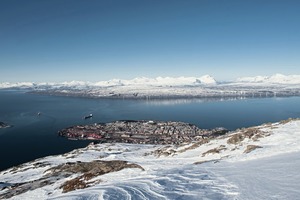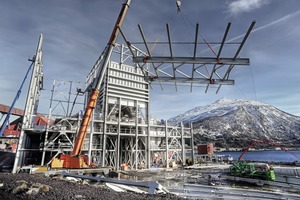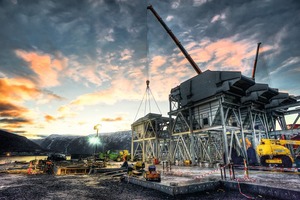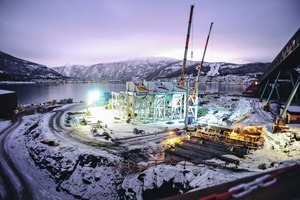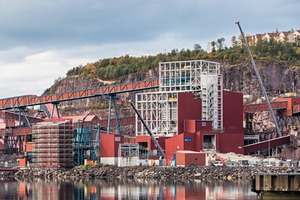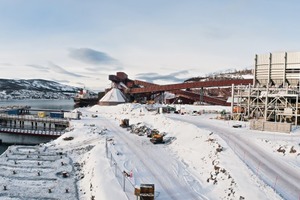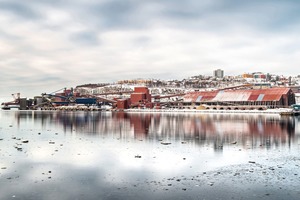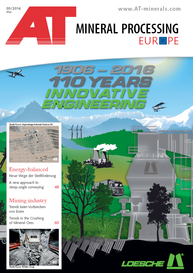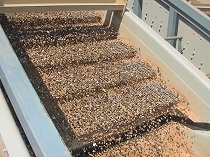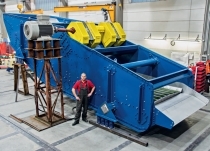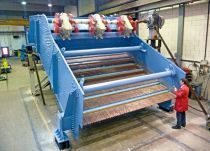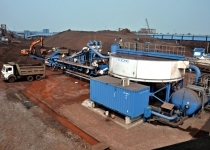Full Screening Power at the Arctic Circle in Norway
Kiruna, the northernmost city of Sweden, is home to an iron ore mine of the same name, which processes and stores pellets. These iron ore pellets are transported from Sweden to Norway for shipping. In 1902, a train line was built all the way to Narvik for this purpose. At the time this was the most northern train line in the world. The trains using this route pull up to 68 rail carts and transport around 33 million tons or iron ore per year. A special automated unloading station can unload one of these carts in only 5 seconds.
Narvik is situated at the Ofotfjord, north of the Arctic Circle, and has an average annual temperature of around 4° C. Thanks to these temperatures, which are influenced by the Gulf Stream, the fjord remains free of ice almost all year round. These weather conditions have made Narvik one of the most important ports for shipping iron ore.
This is where the processing plant of Scandinavia’s biggest iron ore producer is located, with a facility for direct loading of iron ore pellets onto ships. The existing plant has a processing rate of 6000 t/h, and a new plant with a processing rate of an additional 9000 t/h had to be added. The reason for this expansion is to ensure safe and flexible supply of iron ore pellets for the coming decades.
In close cooperation with the customer, JOEST developed a new processing plant for the screening of iron ore pellets and a conveying system for the loading onto ships. The new screening plant system consists of a storage bunker system, six large double-deck vibrating screens with chutes, various connecting belt conveyors as well as a crusher.
The scope of delivery also included the entire steel structure, detailed planning, project management as well as installation and start-up. Throughout the planning and implementation phase, the project team was always on site in order to discuss and manage the current status of the project in close cooperation with the customer.
Storage Bunker System
The storage bunker dimensions are 19 x 11 x 13 m and allow the customer to store 1600 m3 of iron ore pellets. The 11-16 mm pellets can be transported to the bunker using three different belts from different storage systems. A special design ensure that the bunker is filled evenly in the best possible way.
The steel bunker, which weighs approx. 350 t, is split into six equal segments. Another special design was developed to make sure that the pellets are transported as careful as possible to avoid loss of product. Each part of the bunker consists of two hydraulic needle gates, which serve as an emergency shut off systems.
Bunker Discharge Feeder
Underneath each of the six bunker segments a large exciter driven JOEST feeder is discharging the material onto the vibrating screens. The special design avoids any material blockages and ensure very high discharge volumes of up to 9000 tons of iron ore pellets per hour.
Vibrating Screens
The heart of the screening plant are the six double-deck vibrating screens, each with a width of 3000 mm and a length of 9200 mm. The screening plant has an impressive size of 41 x 26 x 42 m using more than 1700 tons of steel for the construction. The screens are arranged in a back-to-back position for the best material distribution. In terms of maintenance and new installations, it was very important for the customer to be able to exchange the screens separately for maintenance purposes. Two removal positions were set up for this purpose.
Each screen can handle a maximum capacity of 1500 t/h and has an effective screening area of 27.6 m2 per deck. This results in an impressive total screening area of approx. 332 m2, comparable to the size of a lot for a single-family house with a small garden.
The screens classify the input materials into pellets, finer and larger material particles. The pellets are moved directly onto the belt for loading onto ships. The finer material, with a size range of 0-6 mm, is transported separately into a fines hopper and converted back into pellets in a separate process. The larger material ranging from 20-50 mm is conveyed to the Oversize Material Handling.
Oversize Material Handling
The larger material (approx. 1-2 %) that got screened out is broken down by a crusher and then returned to the fine material belt conveyor. This way, all of the customer’s material stays in the process and can be sold.
Belt Conveyer
The entire plant contains 12 conveyor belts with a total length of 410 m. The conveyor belt widths ranges between 800, 1000, 1600 and 2000 mm. The belts move the material at up to 3 m/s. The belt conveyor also fully met the customer’s high quality requirement and design guidelines.
Bypass
The customer has the option to bypass the entire plan and to transport all of the material directly for loading onto a ship using a 23 m bypass. The bypass also has the task of moving up to 11 000 tons of fine ore per hour which this does not need to be screened and thus can be moved directly to the ship.
Benefits
Any incorporated moving components, such as screens and hoppers, are attached to a separate steel substructure which is not connected to the screening plant, thereby minimizing the transmission of vibrations.
All screening equipment and bunker discharge feeder are further equipped with an isolation frame. These reduce the remaining dynamic forces into the steel construction using also an additional shock absorber. The result is an optimized mass ratio between the vibrating equipment and the isolation frame. Therefore, the effective degree of isolation exceeds 90 %.
The large standard AC motors of the screening equipment in the old plant are using V-belts, which must be replaced at regular intervals. In order to keep the maintenance costs of the new plant as low as possible, the customer followed the JOEST recommendation and decided for a direct drive with a frequency converter.
All conveyor belts have a hydraulic tensioning device. The longer, rising belts also have an inbuilt brake, which prevents the belt from moving backwards and emptying itself.
Training
The training at the plant following the installation was part of the scope of supply. JOEST experts trained the customer’s operators and maintenance people on site in both in theory and practice. The theoretical part focused on knowledge relating to maintenance and cleaning of the plant. The practical part, e.g. an exchange of a belt drum or screen cover so that the employees would be able to carry out this work quickly and without problems themselves.
Installation and Start-up
After an extensive I/O check, which e.g. determined whether all the cabling had been laid correctly and all electrical signals were correct, cold start-up took place for each individual machine. To achieve this, each machine was switched on and tested separately without material. These successful individual tests formed the basis of cold start-up of the entire equipment for automatic operations. Checks e.g. included whether the switch-off intervals between the machines were set correctly.
Special Challenges
The special challenges of this project consisted of the customer’s high requirements, especially in terms of the quality of the equipment, screening efficiency, high durability, ease of maintenance, and a high level of automation. The outer shell of the screening plant was closed just in time for the cold weather and short days of the Scandinavian winter at the end of last year, in spite of the tight schedule.
How it all began
A successful project in 2012 was the foundation for one of the biggest orders in the company’s history. JOEST already delivered a similarly large double-deck screen with movable hopper discharge feeder to the same customer. During this first project, the customer already specified the requirements for the new expansion plant. The installation into the existing, very narrow screening plant in 2012 was very difficult but JOEST solved this challenge without problems. Once the customer had been convinced of the precise, efficient solution and technical expertise of JOEST, the company was chosen as the supplier for the current large-scale project.
$(LEhttp://

